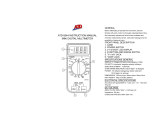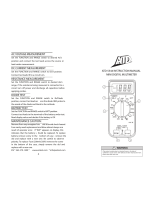
- 6 -
FIG.1
OPERATION AND USE
-WARNINGS: Each time before you use this analyser, inspect the test leads, connectors and
probes for damage, e.g. cracks or breaks in the insulation. Any defective leads should be
replaced immediately. If the value to be measured is not known, set the selector switch to the
highest range and reduce until a satisfactory reading is obtained.
- VOLTAGE MEASUREMENT:
1. Connect the red test lead to the ‘V/ /mA’ jack socket and the black lead to the ‘com’ jack
socket Ensure the leads are correctly plugged in.
2. Position the selector switch to the desired voltage range and switch the meter ‘ON’.
3. Connect the test leads to the circuit to be measured.
4. Turn on the power to the circuit to be measured, the voltage value should appear on the
digital display along with the voltage polarity (if reversed only).
- CURRENT MEASUREMENT (Fig.1.):
1. Connect the red test lead to the ‘V/ /mA’ jack socket and the black lead to the ‘com’ jack
socket (max 10A).
2. Position the selector switch to the desired amp range and switch the meter ‘ON’.
3. Open the circuit to be measured, and connect the test leads in series to bridge the gap.
4. Turn on the power to the circuit to be measured, the ‘current’ value should appear on the
digital display.
- RESISTANCE MEASUREMENT:
-WARNING: If the resistance to be measured is part of a circuit, turn off and disconnect the
power and discharge all capacitors before measurement
1. Connect the red test lead to the ‘V/ /mA’ jack socket and the black lead to the ‘com’
jack socket.
2. Position the selector switch to
the desired ohm range and
switch the meter ‘ON’.
3. Connect the test leads to the
circuit to be measured.
4. The resistance value should now
appear on the digital display.













